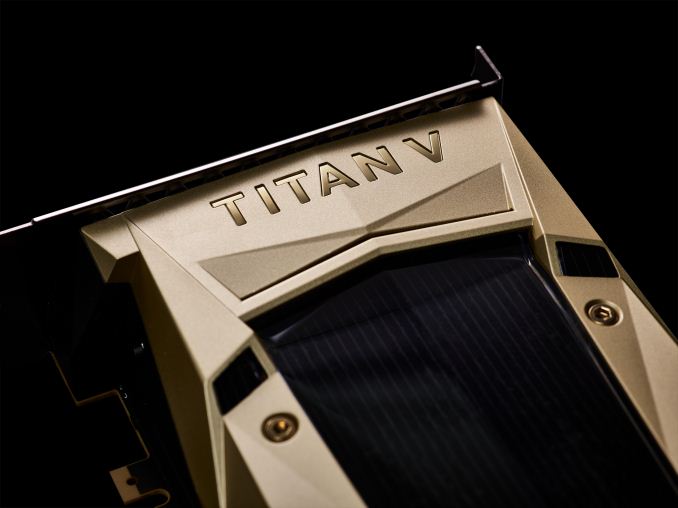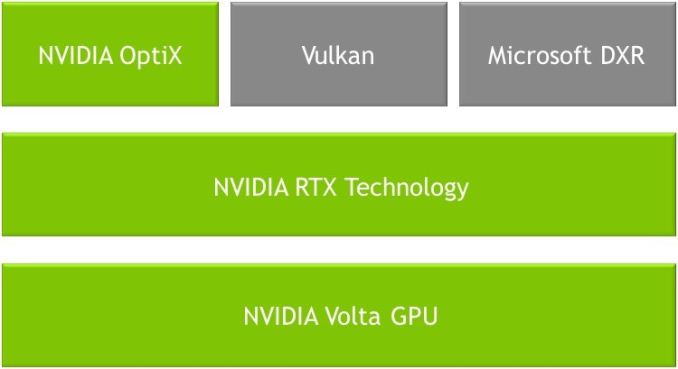The NVIDIA Titan V Deep Learning Deep Dive: It's All About The Tensor Cores
by Nate Oh on July 3, 2018 10:15 AM ESTFinal Words
As we bring this deep dive to close, I should state that DL performance benchmarking on GPUs is very much an ongoing project. For one, everything we've discussed today has been limited to image classification and CNNs, which is very standard as far as GPU deep learning goes, and very standard in its insight. It also plays to some of the traditional DL strengths of GPUs – and of tensor cores and library support for that matter – and in the end, the only featured end-to-end tests were the CIFAR10 implementations.
What we didn't cover was the plethora of failed benchmark runs from various other tests and suites. It proved impossible to find, in piecemeal or in whole, an up-to-date DL suite that ran modern workloads, provided end-to-end metrics, covered multiple ML domains, included tensor core and mixed precision support, and could be reasonably accessible and used by a non-developer.
Because tensor cores are such an important part of the Titan V, it is only natural that we utilize them in our tests. And as AnandTech is not a ML research organization, developing our own robust benchmarkable model in a given framework was not an option. Similarly, we are limited in directly modifying tests and models ourselves. Reworking scripts is one thing, but once you have to go peeling through random Python code of both the models and various supporting functions for whatever framework, the task becomes a little out of scope.
Meanwhile, DAWNBench and competition-type collections were ultimately designed for researchers and developers to create their own implementations, rather than providing a generalizable benchmark. Reference implementations as maintained by the DL frameworks still would need modification to show that it could be a valid benchmark. And if it isn't obvious already, re-configuring a model for Volta-compatible mixed precision is not something that can (usually) be done on the fly.
As a whole, this actually bears relevance to the Titan V. Tensor cores and mixed precision require not just explicit support: they need development. And while the performance boost is clearly evident in particular cases, it's not there in all cases. Even when you have code and datasets that mesh well with the tensor core execution model, at the end of the day neural network processing isn't bottlenecked solely by ALUs. So while the Titan V is capable of being much more powerful than past NVIDIA GPU designs – sometimes massively so – the kinds of performance gains that NVIDIA likes to promote are understandably some of the best-case results.
What this means for anyone thinking about purchasing the Titan V for compute needs is that investing a Titan V means investing in mixed precision DL models and/or WMMA-based GEMM acceleration for HPC (with the assistance of CUTLASS and such). Titan cards have always been prosumer, but the Titan V really makes its mark as a professional consumer card.
Meanwhile in the context of cuDNN/cuBLAS, as well as early mixed precision with DP4A and FP16x2, tensor cores are a natural evolution in attempting to hit a bullseye with programmable hardware for DL acceleration. Of which release notes of recent cuDNN versions list various issues with tensor core math and operations, so bugfixing is very much an ongoing process. Yet tensor cores are even more limited than 'deep learning matrix-matrix multiplications,' except all the details and implementations are not relevant to end-users.
But what about mainstream consumers? What does all of this tensor core development mean for them? Despite the focus here on neural networking, the tensor cores are expected to have some relevance and use in the consumer graphics space. We know that NVIDIA's recent-ish RTX ray tracing technology uses tensor cores to apply denoising on images to make up for limited number of rays. But at the same time, that type of a use case for tensor cores implicates a very different product than the Titan V. RTX hardware functionality will be opaque to end-users, much like a supposed near-future where FP16x2/Rapid Packed Math would be used in video games. And development of tensor core utilization needs to reach that point.
One other consumer-focused role that NVIDIA will be considering for any kind of mainstream parts is whether they want to include tensor cores for development debugging purposes. This is a similar route that NVIDIA already takes today with FP64 functionality, including a handful of FP64 CUDA cores in each GPU so that developers can run FP64 code natively, just very slowly. Right now the Titan V is the only game in town if you need to debug your tensor code on real hardware, but that can certainly (and arguably is likely to) change once mainstream GPUs get a chance to play catch-up.
Meanwhile, NVIDIA's traditional hardware development cadence and redacted Hot Chips talks point to a new consumer lineup in the near future, and it will be very interesting to see what architectural features turn up. What we can say is that the Titan V definitely has the marks of NVIDIA's future GPGPU aspirations. And the Titan V is not merely a deep learning accelerator, because the tensor cores are in essence not merely deep learning accelerators. Moving forward, we're hoping that MLPerf and similar efforts make good headway, so that we can tease out a bit more secrets from GPUs.












65 Comments
View All Comments
Ryan Smith - Tuesday, July 3, 2018 - link
To clarify: SXM3 is the name of the socket used for the mezzanine form factor cards for servers. All Titan Vs are PCie.Drumsticks - Tuesday, July 3, 2018 - link
Nice review. Will anandtech be putting forth an effort to cover the ML hardware space in the future? AMD and Intel both seem to have plans here.The V100 and Titan V should have well over 100TF according to Nvidia in training and inference, if I remember correctly, but nothing I saw here got close in actuality. Were these benches not designed to hit those numbers, or are those numbers just too optimistic in most scenarios to occur?
Ryan Smith - Tuesday, July 3, 2018 - link
"The V100 and Titan V should have well over 100TF according to Nvidia in training and inference"The Titan V only has 75% of the memory bandwidth of the V100. So it's really hard to hit 100TF. Even in our Titan V preview where we ran a pure CUDA-based GEMM benchmark, we only hit 97 TFLOPS. Meanwhile real-world use cases are going to be lower still, as you can only achieve those kinds of high numbers in pure tensor core compute workloads.
https://www.anandtech.com/show/12170/nvidia-titan-...
Nate Oh - Tuesday, July 3, 2018 - link
To add on to Ryan's comment, 100+ TF is best-case (i.e. synthetic) performance based on peak FMA ops on individual matrix elements, which only comes about when everything perfectly qualifies for tensor core acceleration, no memory bottleneck by reusing tons of register data, etc.remedo - Tuesday, July 3, 2018 - link
Nate, I hope you could have included more TensorFlow/Keras specific benchmarks, given that the majority of deep learning researchers/developers are now using TensorFlow. Just compare the GitHub stats of TensorFlow vs. other frameworks. Therefore, I feel that this article missed some critical benchmarks in that regard. Still, this is a fascinating article, and thank you for your work. I understand that Anandtech is still new to deep learning benchmarks compared to your decades of experience in CPU/Gaming benchmark. If possible, please do a future update!Nate Oh - Tuesday, July 3, 2018 - link
Several TensorFlow benchmarks did not make the cut for today :) We were very much interested in using it, because amongst other things it offers global environmental variables to govern tensor core math, and integrates somewhat directly with TensorRT. However, we've been having issues finding and using one that does all the things we need it to do (and also offers different results than just pure throughput), and I've gone so far as trying to rebuild various models/implementations directly in Python (obviously to no avail, as I am ultimately not an ML developer).According to people smarter than me (i.e. Chintala, and I'm sure many others), if it's only utilizing standard cuDNN operations then frameworks should perform about the same; if there are significant differences, a la the inaugural version of Deep Learning Frameworks Comparison, it is because it is poorly optimized for TensorFlow or whatever given framework. From a purely GPU performance perspective, usage of different frameworks often comes down to framework-specific optimization, and not all reference implementations or benchmark suite tests do what we need it to do out-of-the-box (not to mention third-party implementations). Analyzing the level of TF optimization is developer-level work, and that's beyond the scope of the article. But once benchmark suites hit their stride, that will resolve that issue for us.
For Keras, I wasn't able to find anything that was reasonably usable by a non-developer, though I could've easily missed something (I'm aware of how it relates to TF, Theano, MXNet, etc). I'm sure that if we replaced PyTorch with Tensorflow implementations, we would get questions on 'Where's PyTorch?' :)
Not to say your point isn't valid, it is :) We're going to keep on looking into it, rest assured.
SirPerro - Thursday, July 5, 2018 - link
Keras has some nice examples in its github repo to be run with the tensorflow backend but for the sake of benchmarking it does not offer anything that it's not covered by the pure tensorflow examples, I guessBurntMyBacon - Tuesday, July 3, 2018 - link
I believe the GTX Titan with memory clock 6Gbps and memory bus width of 384 bits should have a memory bandwidth of 288GB/sec rather than the list 228GB/sec. Putting that aside, this is a nice review.Nate Oh - Tuesday, July 3, 2018 - link
Thanks, fixedJon Tseng - Tuesday, July 3, 2018 - link
Don't be silly. All we care about is whether it can run Crysis at 8K.